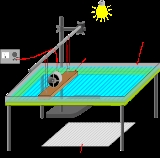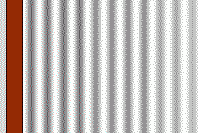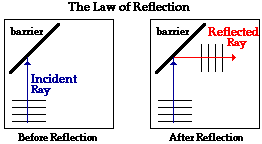
The ripple tank is a container that when filled with water permits the study of water waves.A concentrated light source positioned above the tank forms images of the waves on a screen beneath the tank.Wave crests and troughs project light and dark lines in the screen.

The crests act as converging lenses that focus light,producing the bright lines..The troughs act as diverging lenses that scatter light, producing the dark lines.
The depth at which the dipper is placed affects the amplitude of the waves, while the frequency of waves is determined by frequency of vibration of the dipper.
Refraction of waves and the depth of ripple tank
Refraction of waves involves a change in the direction of waves as they pass from one medium to another. Refraction is the bending of the path of the waves.It is accompanied by a change in speed and wavelength of the waves. It was mentioned that the speed of a wave is dependent upon the properties of the medium through which the waves travel. So if the medium (and its properties) are changed, the speed of the waves are changed.
The most significant property of water which would affect the speed of waves traveling on its surface is the depth of the water.
This boundary behavior of water waves can be observed in a ripple tank if the tank is partitioned into a deep and a shallow section. If a pane of glass is placed in the bottom of the tank, one part of the tank will be deep and the other part of the tank will be shallow. Waves traveling from the deep end to the shallow end can be seen to refract (i.e., bend), decrease wavelength (the wave fronts get closer together), and slow down (they take a longer time to travel the same distance). When traveling from deep water to shallow water, the waves are seen to bend in such a manner that they seem to be traveling more perpendicular to the surface.If traveling from shallow water to deep water, the waves bend in the opposite direction.

Water waves travel fastest when the medium is the deepest. Thus, if water waves are passing from deep water into shallow water, they will slow down and also the wavelength of the plane waves shorten.The frequency remains the same as it is determined by the dipper.Using the equation, v:f x L,the speed of the waves is therefore slower at the shallow water.

Refraction of waves can be demonstrated by placing the plastic sheet at an angle to the incoming waves .As observed earlier, the differene in the depth of water causes a change in speed of waves.Similar to light, when waves enter a region of shallow water at an angle, the waves refract.

Reflection of waves can be demonstrated by placing a straight barrier upright in the water causing the incoming incident waves to be reflected.The law of reflection is obeyed and the Angle of incidence is equal to the angle of reflection.

Reflection, refraction and diffraction are all boundary behaviors of waves associated with the bending of the path of a wave. The bending of the path is an observable behavior when the medium is a two- or three-dimensional medium. Reflection occurs when there is a bouncing off of a barrier. Reflection of waves off straight barriers follows the law of reflection. Reflection of waves off parabolic barriers results in the convergence of the waves at a focal point. Refraction is the change in direction of waves which occurs when waves travel from one medium to another. Refraction is always accompanied by a wavelength and speed change. Diffraction is the bending of waves around obstacles and openings. The amount of diffraction increases with increasing wavelength.
Thanks so much!!!!!!!
ReplyDeletethanks for the info, goood for homework
ReplyDeletethanks!!!!!!
ReplyDeleteThanks a lot be blessed
ReplyDeleteAwesome
ReplyDelete